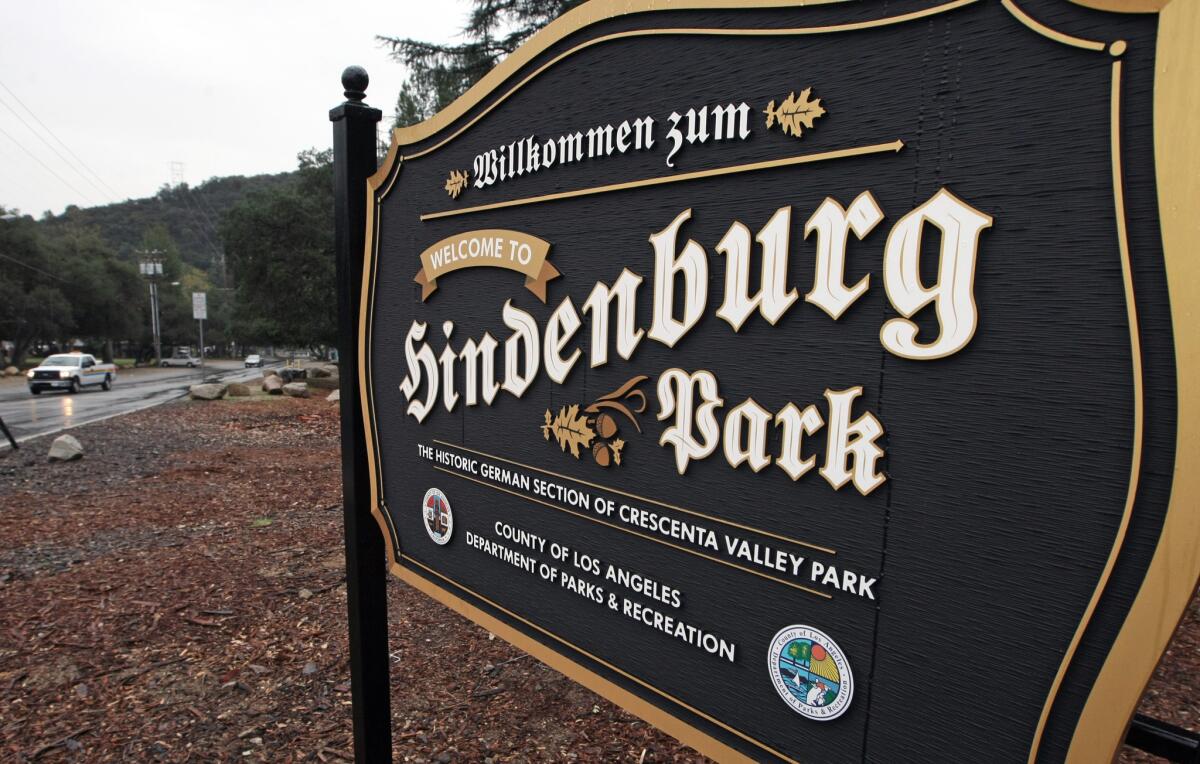Intersections: Resolving heritage and history in La Crescenta

In February, Los Angeles County put up a sign for Hindenberg Park which has been at the west end of Crescenta Valley Park since it was purchased by the county in 1958.
Earlier this year, an almost 6-foot sign appeared in Crescenta Valley Park. In gold and white lettering, with added design elements of oak leaves and acorns, it welcomed visitors to Hindenburg Park, “the historic German section of Crescenta Valley Park.”
Though the county of Los Angeles Department of Parks and Recreation’s stamp appears on the sign as well, it was a private group, a German heritage organization named the Tricentennial Foundation, that paid for it — $2,500 to be exact according to Kaye Michelson, who is the acting public information officer for the department and was quoted in a Jewish Journal article about the sign.
MORE: Read more of Liana’s columns >>
The sign is a tribute to German-American heritage in Los Angeles and recalls that the area was named after Paul Von Hindenburg, the second president of Germany who served from 1925 to 1934 and was one of the country’s most esteemed war heroes.
He was elected to his second term with “the support of those who saw him as a protection against Nazi lawlessness and brutality,” according to the BBC, yet he eventually, under pressure, ended up playing a vital role in helping Hitler rise to power and establish a Nazi dictatorship.
NEWSLETTER: Get the latest 818 headlines straight to your inbox >>
According to the Crescenta Valley Historical Society, that particular section of the park featured a large bust of Hindenburg back in the day and was the site of a variety of German cultural celebrations with bands, plays, parades and a lot of beer and bratwurst.
It was also the home of the first Oktoberfest in California in 1956. Owned by the German-American League, it sold that portion to L.A. County.
But it holds a darker history, too. It was the site of the Bund, the American arm of the Nazi Party, where rallies and meetings celebrating Hitler and the Third Reich were held. A youth camp taught children about customs and traditions of Germany under the Third Reich. The Oviatt Library Digital Collections at California State University Northridge holds archival material about Nazi activities in La Crescenta, including old fliers and disturbing black-and-white photos.
And it’s exactly this history that has caused controversy among some residents of La Crescenta and greater Los Angeles.
The Jewish Federation of the Greater San Gabriel and Pomona Valleys said in a press release this week that it vehemently protests the sign, adding that, “The Jewish Federation understands the desire to recognize and honor German-American culture, but feels that there are many more ways that this can be done … especially in a manner that does not evoke memories of one of the world’s worst atrocities to ever take place.”
We are all seeking ways to honor our culture and remember our identities, so when issues like this come up, they require hard examination. How do we respect where we came from, while also acknowledging horrific moments in history and how they impacted (and often still impact) certain communities, even if they don’t impact us? How do we properly deal with our identities? What does it take to come to peace with atrocities, if any peace can come of it at all?
These are difficult questions to think about, and they’re questions that linger for me when I hear about these issues, whether it’s a park sign, a commemorative statue or organized events that spark outrage, especially as I try to balance self-examination and a history heavy with inhumanity.
I think, at least for the communities that we live in, the only way we can get a consensus, understand each other’s concerns and even heal is actually engaging in discussion and conversation, and also honestly acknowledging the points in our history we want to forget or gloss over.
Maybe we need to discuss that La Crescenta, however small and quaint, has been home to nefarious activity, too, that at some point people openly supported something that can only be described as pure evil.
Luckily, the L.A. County Human Relations Commission is giving people the opportunity to do just that. On April 7, from 4 to 6 p.m., a public hearing will take place at the Sparr Heights Community Center in the Verdugo Room at 1614 Glencoe Way.
People will be allowed to speak, and then the commission will be deciding what recommendation to make to the Parks and Recreation Department regarding the sign.
So much has happened in the world, and still continues to happen, because people stay silent or choose not to be actively engaged. It was actually Hitler who said, “How fortunate for governments that the people they administer don’t think.”
If you have strong feelings about this sign, or want the opportunity to connect with the history of where you live, I urge you to go.
--
LIANA AGHAJANIAN is a Los Angeles-based journalist whose work has appeared in L.A. Weekly, Paste magazine, New America Media, Eurasianet and The Atlantic. She may be reached at liana.agh@gmail.com.